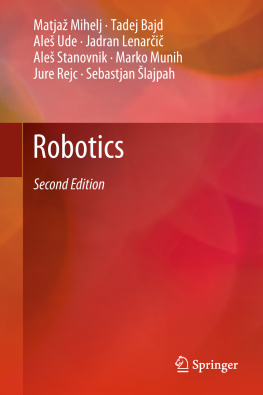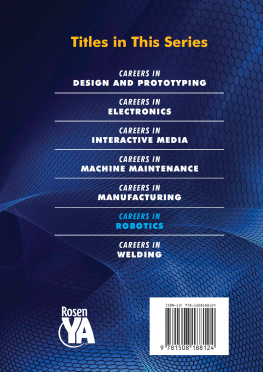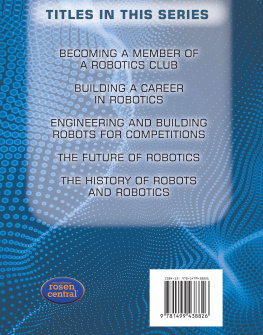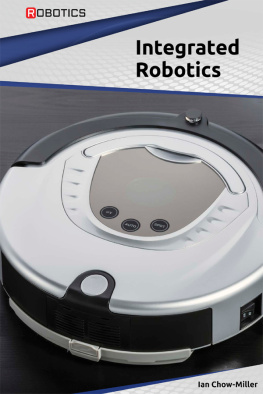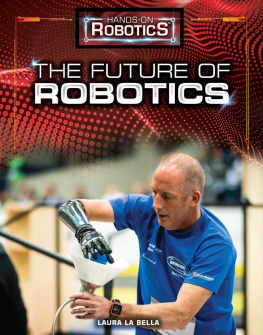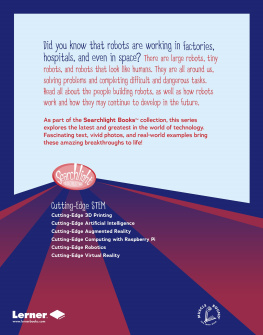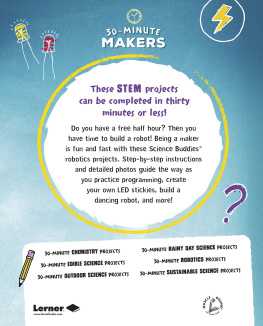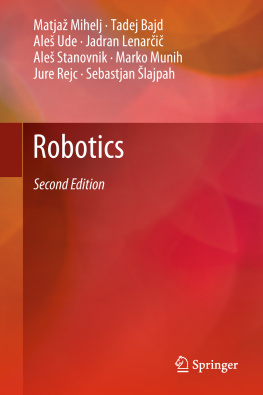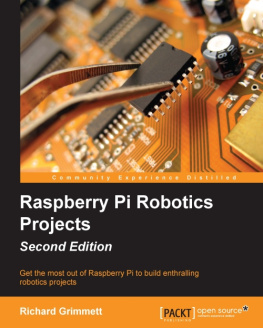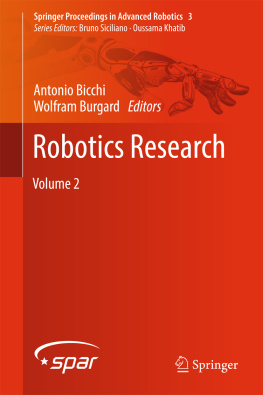MatjaЕѕ Mihelj - Robotics
Here you can read online MatjaЕѕ Mihelj - Robotics full text of the book (entire story) in english for free. Download pdf and epub, get meaning, cover and reviews about this ebook. year: 0, publisher: Springer International Publishing, genre: Children. Description of the work, (preface) as well as reviews are available. Best literature library LitArk.com created for fans of good reading and offers a wide selection of genres:
Romance novel
Science fiction
Adventure
Detective
Science
History
Home and family
Prose
Art
Politics
Computer
Non-fiction
Religion
Business
Children
Humor
Choose a favorite category and find really read worthwhile books. Enjoy immersion in the world of imagination, feel the emotions of the characters or learn something new for yourself, make an fascinating discovery.
- Book:Robotics
- Author:
- Publisher:Springer International Publishing
- Genre:
- Year:0
- Rating:5 / 5
- Favourites:Add to favourites
- Your mark:
- 100
- 1
- 2
- 3
- 4
- 5
Robotics: summary, description and annotation
We offer to read an annotation, description, summary or preface (depends on what the author of the book "Robotics" wrote himself). If you haven't found the necessary information about the book — write in the comments, we will try to find it.
Robotics — read online for free the complete book (whole text) full work
Below is the text of the book, divided by pages. System saving the place of the last page read, allows you to conveniently read the book "Robotics" online for free, without having to search again every time where you left off. Put a bookmark, and you can go to the page where you finished reading at any time.
Font size:
Interval:
Bookmark:
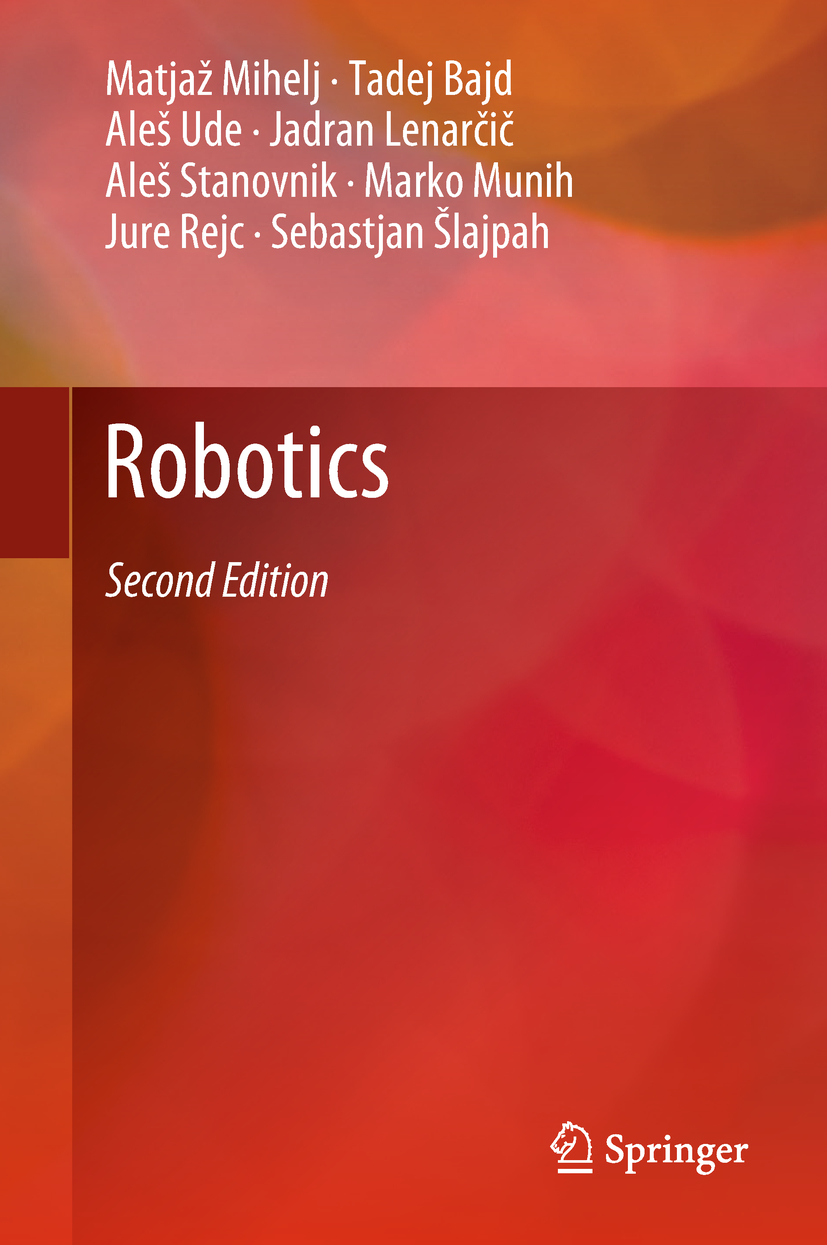

This Springer imprint is published by the registered company Springer International Publishing AG part of Springer Nature
The registered company address is: Gewerbestrasse 11, 6330 Cham, Switzerland
It is perhaps difficult to agree on what a robot is, but most people working in robotics would probably quote the Father of Robotics, Joseph F. Engelberger (19252015), a pioneer in industrial robotics, stating I cant define a robot, but I know one when I see one.
The word robot does not originate from a scientific or engineering vocabulary, but was first used in the Czech drama R.U.R. (Rossums Universal Robots) by Karel apek, that was first played in Prague in 1921. The word itself was invented by his brother Josef. In the drama the robot is an artificial human being which is a brilliant worker, deprived of all unnecessary qualities, such as emotions, creativity, and the capacity for feeling pain. In the prologue of the drama the following definition of robots is given: Robots are not people ( Roboti nejsou lid ). They are mechanically more perfect than we are, they have an astounding intellectual capacity, but they have no soul. The creation of an engineer is technically more refined than the product of nature.
The book Robotics evolved through decades of teaching robotics at the Faculty of Electrical Engineering, University of Ljubljana, Slovenia, where the first textbook on industrial robotics was published in 1980 (A. Kralj and T. Bajd, Industrijska robotika ). The way of presenting this rather demanding subject was successfully tested with several generations of undergraduate students.
The second edition of the book continues the legacy of the first edition that won the Outstanding Academic Title distinction from the library magazine CHOICE in 2011. The major feature of the book remains its simplicity. The introductory chapter now comprehensively covers different robot classes with the main focus on industrial robots. The position, orientation, and displacement of an object are described by homogenous transformation matrices. These matrices, which are the basis for any analysis of robot mechanisms, are introduced through simple geometrical reasoning. Geometrical models of the robot mechanism are explained with the help of an original, user-friendly vector description. With the world of the roboticist being six-dimensional, orientation of robot end effectors received more attention in this edition.
Robot kinematics and dynamics are introduced via a mechanism with only two rotational degrees of freedom, which is however an important part of the most popular industrial robot structures. The presentation of robot dynamics is based on only the knowledge of Newtons law and was additionally simplified for easier understanding of this relatively complex matter. The workspace plays an important role in selecting a robot appropriate for the planned task. The kinematics of parallel robots is significantly different from the kinematics of serial manipulators and merits additional attention.
Robot sensors presented in this edition are relevant not only for industrial manipulators, but also for complex systems such as humanoid robots. Robot vision has an increasingly important role in industrial applications and robot trajectory planning is a prerequisite for successful robot control. Basic control schemes, resulting in either the desired end-point trajectory or in the force between the robot and its environment, are explained. Robot environments are illustrated by product assembly processes, where robots are a part of a production line or operate as completely independent units. Robot grippers, tools, and feeding devices are also described.
With the factory floor becoming ever more complex, interaction between humans and robots will be inevitable. Collaborative robots are designed for safe human-robot interaction. Flexibility of production can be further increased with the use of wheeled mobile robots. A glimpse into the future, when humans and robots will be companions, is presented in the chapter on humanoid robotics, the complexity of which requires more advanced knowledge of mathematics. The chapter on standardization and measurement of accuracy and repeatability is of interest for users of industrial robots.
The book requires a minimal advanced knowledge of mathematics and physics. It is therefore appropriate for introductory courses in robotics at engineering faculties (electrical, mechanical, computer, civil). It could also be of interest for engineers who had not studied robotics, but who have encountered robots in the working environment and wish to acquire some basic knowledge in a simple and fast manner.
Font size:
Interval:
Bookmark:
Similar books «Robotics»
Look at similar books to Robotics. We have selected literature similar in name and meaning in the hope of providing readers with more options to find new, interesting, not yet read works.
Discussion, reviews of the book Robotics and just readers' own opinions. Leave your comments, write what you think about the work, its meaning or the main characters. Specify what exactly you liked and what you didn't like, and why you think so.

